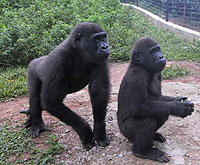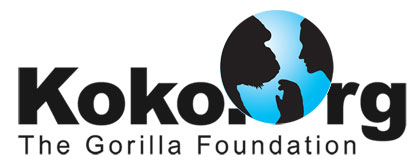African Travel Update by the Director of Gorilla Foundation’s Wildlife Protector Fund (WPF), Dr. Tony Rose.
The whirlwind settled: After nine weeks living out of a too-small suitcase and making connections on sixteen air flights into six African countries, there was a tenuous feeling about being “at home.” I looked at the international clock on my desk to remind myself that my friends and coworkers were ending their workdays in Cameroon, heading home in South Africa, Botswana, Zimbabwe and Zambia, and finishing supper in Kenya. Here in California I had my second cup of morning coffee and shuffled through piles of mail and accumulated tasks. But images of travel, from ape orphans in cages to leopards on the prowl, kept taking me back.
The first ten days of my recent trek to Africa were spent in Kenya on two missions — working on our “bushmeat book” with Karl Ammann and attending the meetings of the Pan African Sanctuary Alliance (PASA).
Most straight-forward was the task of revising text and images for the book on African wildlife commerce — Consuming Life. Karl and I had spent ten days in March outlining the first draft of the book, and are enthused about the outcome of our collaboration. I am now integrating the editorial contributions of other co-authors into the manuscript. I expect the next draft to take a solid month of work to complete. Two hundred pages of text with 350 photographs, full color — a big project. Fortunately publication grants from Conservation International and Margot Marsh Biodiversity Foundation are helping us to fast-track this project. We expect to have the book on your desks and coffee tables before the end of 2002.
The PASA meeting was more complex. Sanctuary managers, donors, and primate experts and supporters from two dozen organizations in as many countries present diverse opinions and experience. Consensus is not easy to find. The selection of Doug Cress, Executive Director of Great Ape Project, to serve during the next year as the PASA secretariat and coordinator gives me hope that progress will be made in amalgamating the organization. It was very useful and inspiring for me to meet with Stella Brewer from Gambia and Sheila Siddle from Zambia. Their decades spent rehabilitating chimpanzees from orphans and pets into fully functioning semi-wild ape communities is legend. My subsequent visit to Chimfunshi Sanctuary in north-west Zambia, along with other vital sanctuary project investigations, added to these learnings. I will discuss these and the PASA conference in a forthcoming report.
 |
| WPF Director Tony Rose consults with young gorilla orphan at Michael Sanctuary in Mefou National Park, Cameroon. |
At the end of the PASA meeting I went with Neil Madisson of Bristol Zoo to meet the principals of the Great Ape Survival Partnership (GRASP) at the UN Environment Program (UNEP) headquarters in Nairobi. UNEP and Bristol are looking for partners to collaborate on conservation outreach experiments in Cameroon. Clearly this is an effort which we would like to support. And a perfect segway to my next destination — Cameroon.
I landed in Yaounde, the capital of Cameroon, after dark and was greeted by our Wildlife Protectors Fund field coordinator, Penny Fraser and her colleague, Colonel Tanko. They deposited me at the Azur Hotel and advised me to get some sleep. Next morning began the most intense seven days I have spent in Cameroon — Penny had organized nonstop meetings and workshops. A full list of projects and people would be too long for this summary report. We did visit the Michael Sanctuary in Mefou National Park and found the gorillas had grown larger and stronger during their year in the large forest enclosure. It was inspiring to see them treking through the forest and climbing trees. The ongoing struggle to manage and staff sanctuary projects in economic hard times is at the top of the list of issues we are facing.
Promising events for our Conservation Values Education program were planning sessions with representatives of US Peace Corps, British High Counsel, Mt. Cameroon Project, Cameroon Wildlife Aid Fund. We also began exploring development of a Concert for Wildlife with popular music promoters and celebrities. I am currently reviewing Penny Fraser’s proposals for a half dozen projects based on our meetings and follow up efforts she has undertaken. These will be reported later.
 |
| WPF Field Coordinator Penny Fraser and Research Associate Rita Lysinge meet with teachers to plan Mt. Cameroon Koko’s Kitten Project |
One exciting immediate outcome of the Cameroon visit is a new research project on the perceptions of gorillas among villagers in western Cameroon. Rita Lysinge of the Mt. Cameroon Project and Limbe Botanic & Zoological Gardens carried out the pilot study in June. A fascinating report detailing local myths about gorillas and the reaction of people to the story of Koko’s Kitten recited in pigeon English appears in the last (Aug. 2002) issue of African News on Koko.org (see archives). In this study we are examining how oral story telling (with pictures from books about Koko and Michael) infuses new legend about apes into community memory. Preliminary findings suggest that village people are beginning to describe gorillas as friendly and sensitive beings who should not be harmed. As we find here in the US, Koko and Michael are quickly converted to icons in Africa.
 |
| Lemurs are among the dozen primates living happily in the forest at the MonkeyLand Sanctuary in Plettenberg Bay, South Africa. |
From Yaounde I flew to Plettenberg Bay, South Africa to visit an exciting new ape sanctuary project being developed by Tony Blignaut, president of the Pan African Association of Zoos and Aquariums. Suffice to say, I agree with other ape experts that if anyone can create viable ape sanctuaries in Africa, it is Tony. His track record with MonkeyLand sanctuary and his competence in business and wildlife tourism will pay off for the great apes. More on this inspiring development to come.
After South Africa I went to Botswana, Zimbabwe, and Zambia. In those countries I experienced how government and military support of wildlife preservation and eco tourism can produce viable conservation scenarios. I also witnessed the potential for such positive situations to unravel when international support and national politics shifts focus away from concern for nature. The details of these investigations will also follow this summary report.
Overall, I must say that my hopes and my fears have been increased simultaneously based on the travels I have just completed. Africa’s people and its natural environments and wildlife inspire my compassion, commitment and awe. Its politics and its social and economic travails evoke deep concern. Our continuing involvement and support is absolutely needed. It is my hope that you will keep informed by checking in on a regular basis to read the forthcoming reports of my journey in Africa, which will be published here, and announced via KokoMail. (More detailed articles—often with more troubling photos— will appear at the Bushmeat Project website (http://bushmeat.net).
And don’t forget to help us continue our work by sending us your ideas and offering your talent and experience. You can contact me directly — [email protected] to get involved. Of course you are always welcome to support the Gorilla Foundation’s Wildlife Protectors Fund by making a donation to The Gorilla Foundation.
Best regards, Tony Rose


